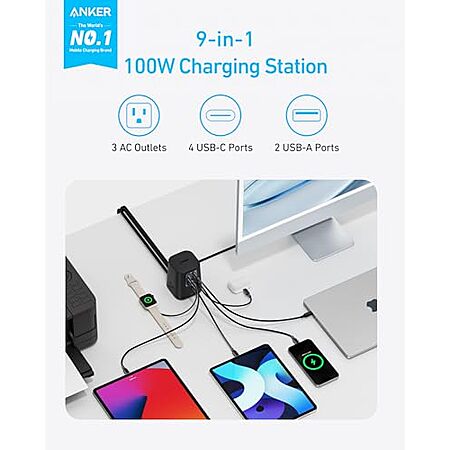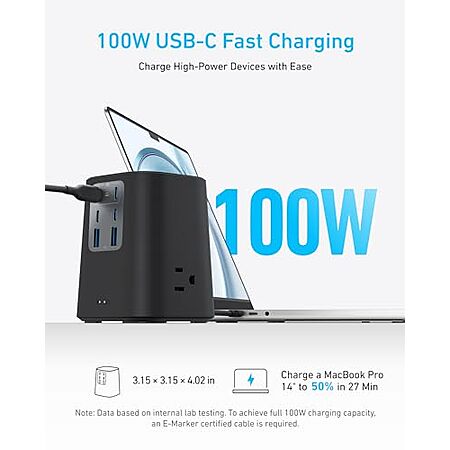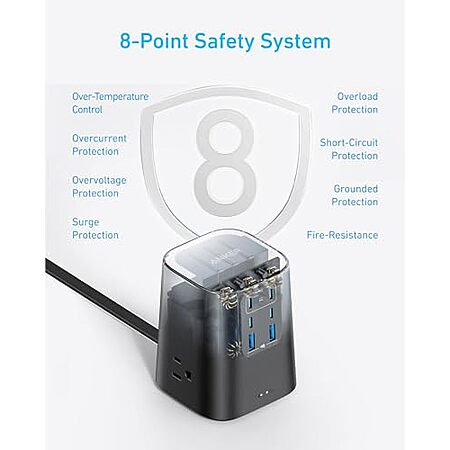You should not daisy chain protective devices (fuses, MOVs, breakers, etc.) without first doing the appropriate research because generally speaking, they are rated to interrupt in x seconds given a particular fault current. When you have two protection devices with similar ratings in the circuit, they end up both trying to interrupt and may very well end up interfering with each other's interruption capability, possibly to the point where neither will properly clamp or interrupt the fault, causing excessive current flow and possibly fires.
e.g. A fuse chosen more or less at random will clear in 1s with a ~20A fault current. If you have a second fuse with similar ratings in series, they will actually start limiting the fault current as they open up, and the fault current is no longer 20A, it may be 15A, or 10A, or ... you get the idea. That same fuse will clear a 10A fault in ~10s, which could be enough time to heat up wire or traces or cause a semiconductor to fail because it wasn't designed to handle that kind of current for that kind of time.
e.g. A MOV series chosen more or less at random will clamp a surge at 130V. Two in parallel will have (slightly or significantly) different clamping voltages, usually with the lower one "winning". The breaker/fuse and MOV are usually selected so that the MOV will clamp and the breaker will open with the surge current, but when you mix and match you end up with a MOV clamping earlier, which the fuse/breaker wasn't designed to trip at, which now alters its fault ratings, leading to unpredictable protection.
=========================
This post can be edited by most users to provide up-to-date information about developments of this thread based on user responses, and user findings. Feel free to add, change or remove information shown here as it becomes available. This includes new coupons, rebates, ideas, thread summary, and similar items.
Once a Thread Wiki is added to a thread, "Create Wiki" button will disappear. If you would like to learn more about Thread Wiki feature, click here.







Leave a Comment
Top Comments
All of the theoretical "cooling" benefits of GaN talk just needs to stop. i definitely have non GaN chargers that run cooler than some of my GaN chargers. It matters more about the quality of components than GaN or not. This being an Anker, I don't have any worries about its temp.
78 Comments
Sign up for a Slickdeals account to remove this ad.
All of the theoretical "cooling" benefits of GaN talk just needs to stop. i definitely have non GaN chargers that run cooler than some of my GaN chargers. It matters more about the quality of components than GaN or not. This being an Anker, I don't have any worries about its temp.
Sign up for a Slickdeals account to remove this ad.
Our community has rated this post as helpful. If you agree, why not thank Admiral_Ackbar
Top 2 USB C it's 100W max combined if both ports are used.
If the top and middle ports are used, The max drops to 80W max or split between the top two and 15W max or split between the middle two.
If the top and bottom are used, that changes to 80 W and 12 W for the bottom.
And if all three tiers of ports are used, the top max is 73W, the middle is 15 and the bottom is 12.
Also, because of surge protector, this cannot be use in Cruise Ship. For charging station, seems like it would be best not to have surge protectors so can use it more places.
**No, it is not okay to daisy chain surge protectors.** Here are the key reasons why:
1. **Violation of Safety Regulations**: Daisy chaining surge protectors is a direct violation of Occupational Safety and Health Administration (OSHA) regulations and the National Electrical Code (NEC). Specifically, NEC Article 110.3(B) and OSHA 29 CFR 1910.303(b)(2) and 1926.403(b)(2) prohibit this practice[1][3][4].
2. **Overload Risk**: Power strips and surge protectors are designed to handle a limited number of outlets. When you daisy chain them, you risk overloading the circuit, which can lead to fires, overheating, and equipment failure[1][2][4].
3. **Increased Electrical Resistance**: Using long extension cords to power surge protectors or power strips increases electrical resistance, generating more heat and adding to the risk of equipment failure and fires[1][2].
4. **Voiding Warranties**: Daisy chaining can void the connected device warranty provided by some manufacturers, as it violates the installation requirements[3].
5. **Non-Compliance with UL Guidelines**: Plugging a power strip into another power strip or current tap breaches Underwriters Laboratories (UL) guidelines, making the installation non-compliant and potentially voiding homeowners' insurance in case of a fire[3].
6. **Electrical Safety Risks**: Daisy chaining can compromise the surge protection effect, potentially leading to slower trigger times for shutoff mechanisms and increased risk of electrical hazards[4].
In summary, daisy chaining surge protectors is dangerous, violates safety regulations, and can lead to serious electrical hazards. It is strongly recommended against this practice to ensure safety and compliance with electrical codes.
Sources
[1] Power Strips and Dangerous Daisy Chains - OCWR https://www.ocwr.gov/publications...
[2] [PDF] EHS Fact Sheet Electrical Safety – Daisy Chaining https://ehs.okstate.edu/site-file..._sheet.p
[3] What you need to know about daisy chaining powerstrips - TrickleStar https://tricklestar.com/pages/wha...owerstrip
[4] Why is it dangerous to daisy-chain surge protectors? - Reddit https://www.reddit.com/r/askscien...rote
[5] Can You Plug a Surge Protector into a Surge Protector: Expert Guide https://www.anker.com/blogs/charg...-protector
[6] Bryant Miles - Daisy Chaining Surge Protectors - LinkedIn https://www.linkedin.co
**No, it is not okay to daisy chain surge protectors.** Here are the key reasons why:
1. **Violation of Safety Regulations**: Daisy chaining surge protectors is a direct violation of Occupational Safety and Health Administration (OSHA) regulations and the National Electrical Code (NEC). Specifically, NEC Article 110.3(B) and OSHA 29 CFR 1910.303(b)(2) and 1926.403(b)(2) prohibit this practice[1][3][4].
2. **Overload Risk**: Power strips and surge protectors are designed to handle a limited number of outlets. When you daisy chain them, you risk overloading the circuit, which can lead to fires, overheating, and equipment failure[1][2][4].
3. **Increased Electrical Resistance**: Using long extension cords to power surge protectors or power strips increases electrical resistance, generating more heat and adding to the risk of equipment failure and fires[1][2].
4. **Voiding Warranties**: Daisy chaining can void the connected device warranty provided by some manufacturers, as it violates the installation requirements[3].
5. **Non-Compliance with UL Guidelines**: Plugging a power strip into another power strip or current tap breaches Underwriters Laboratories (UL) guidelines, making the installation non-compliant and potentially voiding homeowners' insurance in case of a fire[3].
6. **Electrical Safety Risks**: Daisy chaining can compromise the surge protection effect, potentially leading to slower trigger times for shutoff mechanisms and increased risk of electrical hazards[4].
In summary, daisy chaining surge protectors is dangerous, violates safety regulations, and can lead to serious electrical hazards. It is strongly recommended against this practice to ensure safety and compliance with electrical codes.
Sources
[1] Power Strips and Dangerous Daisy Chains - OCWR https://www.ocwr.gov/publications...
[2] [PDF] EHS Fact Sheet Electrical Safety – Daisy Chaining https://ehs.okstate.edu/site-file..._sheet.p
[3] What you need to know about daisy chaining powerstrips - TrickleStar https://tricklestar.com/pages/wha...owerstrip
[4] Why is it dangerous to daisy-chain surge protectors? - Reddit https://www.reddit.com/r/askscien...rote
[5] Can You Plug a Surge Protector into a Surge Protector: Expert Guide https://www.anker.com/blogs/charg...-protector
[6] Bryant Miles - Daisy Chaining Surge Protectors - LinkedIn https://www.linkedin.co
Rather than connecting two devices that have surge protection….
Sign up for a Slickdeals account to remove this ad.
**No, it is not okay to daisy chain surge protectors.** Here are the key reasons why:
1. **Violation of Safety Regulations**: Daisy chaining surge protectors is a direct violation of Occupational Safety and Health Administration (OSHA) regulations and the National Electrical Code (NEC). Specifically, NEC Article 110.3(B) and OSHA 29 CFR 1910.303(b)(2) and 1926.403(b)(2) prohibit this practice[1][3][4].
2. **Overload Risk**: Power strips and surge protectors are designed to handle a limited number of outlets. When you daisy chain them, you risk overloading the circuit, which can lead to fires, overheating, and equipment failure[1][2][4].
3. **Increased Electrical Resistance**: Using long extension cords to power surge protectors or power strips increases electrical resistance, generating more heat and adding to the risk of equipment failure and fires[1][2].
4. **Voiding Warranties**: Daisy chaining can void the connected device warranty provided by some manufacturers, as it violates the installation requirements[3].
5. **Non-Compliance with UL Guidelines**: Plugging a power strip into another power strip or current tap breaches Underwriters Laboratories (UL) guidelines, making the installation non-compliant and potentially voiding homeowners' insurance in case of a fire[3].
6. **Electrical Safety Risks**: Daisy chaining can compromise the surge protection effect, potentially leading to slower trigger times for shutoff mechanisms and increased risk of electrical hazards[4].
In summary, daisy chaining surge protectors is dangerous, violates safety regulations, and can lead to serious electrical hazards. It is strongly recommended against this practice to ensure safety and compliance with electrical codes.
Sources
[1] Power Strips and Dangerous Daisy Chains - OCWR https://www.ocwr.gov/publications...
[2] [PDF] EHS Fact Sheet Electrical Safety – Daisy Chaining https://ehs.okstate.edu/site-file..._sheet.p
[3] What you need to know about daisy chaining powerstrips - TrickleStar https://tricklestar.com/pages/wha...owerstrip
[4] Why is it dangerous to daisy-chain surge protectors? - Reddit https://www.reddit.com/r/askscien...rote
[5] Can You Plug a Surge Protector into a Surge Protector: Expert Guide https://www.anker.com/blogs/charg...-protector
[6] Bryant Miles - Daisy Chaining Surge Protectors - LinkedIn https://www.linkedin.co
Leave a Comment